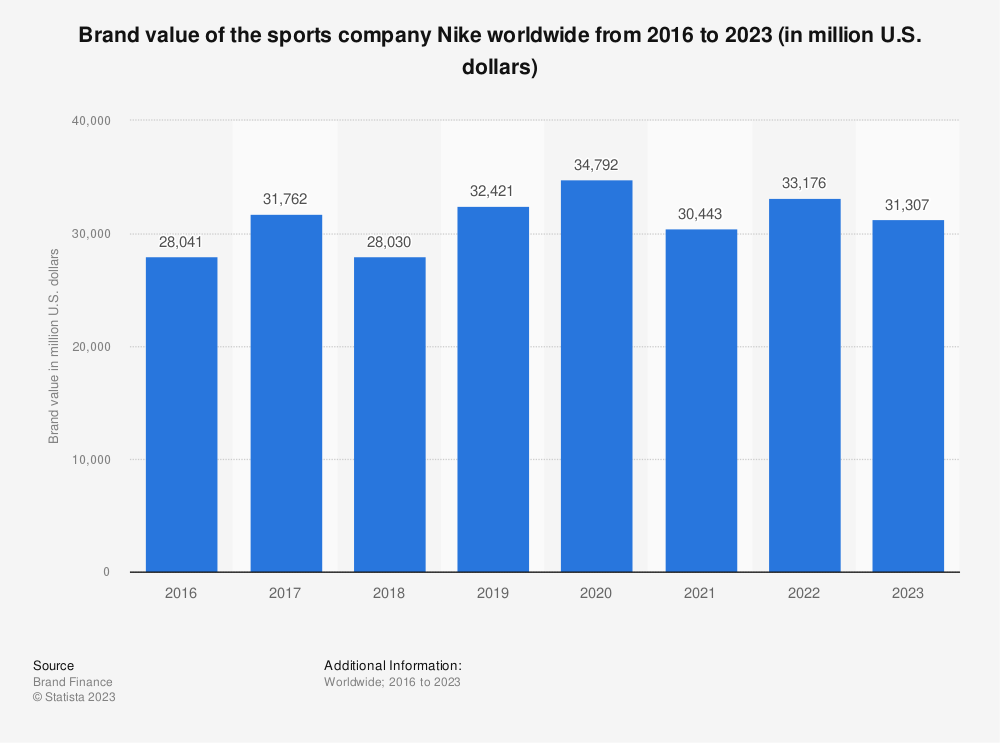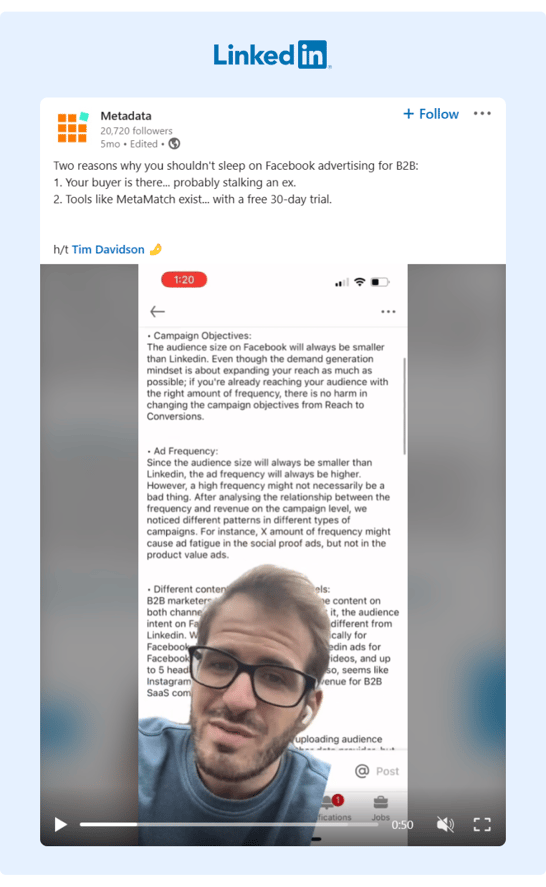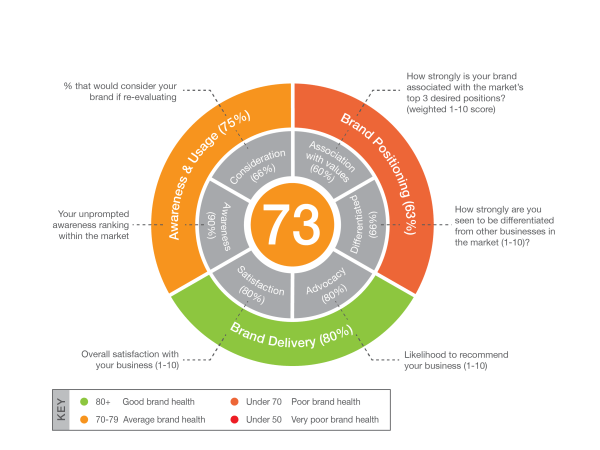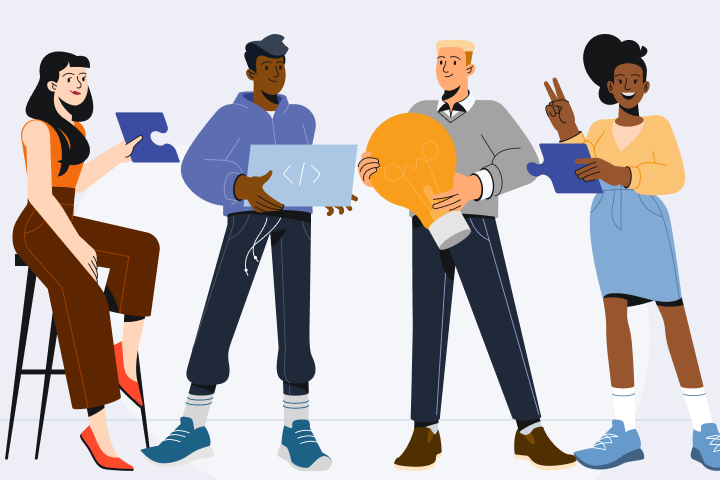In the bustling marketplaces of both digital and brick-and-mortar stores, brand awareness distinguishes one brand from another in the minds of consumers.
But what is brand awareness?
Brand awareness is the familiarity your customers have with your business and its products or services. It keeps your brand top-of-mind when consumers are making purchasing decisions. Whether it's the iconic Nike “swoosh” or Apple's unmistakable bitten apple logo, these symbols resonate with consumers around the globe because of the power of brand awareness.

Source: Statista
Just think about the last time you were shopping for a product. Did you reach for a brand you knew and trusted, or did you take a risk on something unfamiliar? Most often, familiarity wins out, demonstrating the tangible value of brand awareness.
Learning how to create brand awareness requires leveraging both traditional and digital marketing strategies. Everything from billboards and television commercials to social media campaigns and influencer partnerships are contributing factors. The key lies in understanding your audience and tailoring your strategies to engage with them in meaningful ways.
Today, there are several digital tools, like targeted online ads and analytics platforms, that help businesses reach their audience more effectively. Consistency is key. From a brand's voice to its visual elements, everything must align to foster a cohesive and recognizable brand identity.
Equally as important is learning how to create customer awareness, which looks at the customer's knowledge and understanding of a brand. While brand awareness ensures that the consumer recognizes your name or logo, customer awareness dives deeper. It measures the extent to which consumers understand your product's unique selling points.
When considering how to increase awareness, education is vital. In this article, we’re going to explain the five stages of customer awareness, give tips for increasing brand awareness, share brand awareness examples and campaign ideas, and break down how to measure brand awareness.
Let’s get started with the five stages of customer awareness.
5 Stages of Customer Awareness
Businesses are constantly vying for the attention of consumers. With countless products and services available, business success often boils down to customer awareness and understanding. A brand may be globally recognized, but if consumers don’t understand its value proposition, that recognition may not translate to sales or loyalty.
So, what is customer awareness in this context, and why is customer awareness important? Customer awareness guides consumers through the journey from having no knowledge about a product to becoming loyal advocates.

Source: NapierB2B
As a marketer, you have likely seen the Inbound Methodology that HubSpot made popular in how customers become aware of your company (this later became the Flywheel). Whether you want to learn how to increase brand awareness for a small business or how to create awareness of a new product in general, it’s important to get customers’ attention in order to sell products.
This requires a solid brand awareness strategy that incorporates the entire customer awareness journey. The five stages of customer awareness are:
-
Unaware: Initially, the potential customer is unaware of their own problem(s). They live in a state of blissful ignorance, with no recognition of a need or a gap in their lives.
-
Problem Aware: Here, the customer begins to realize that they have a problem or need, but aren't yet aware of the solutions available. For marketers, this is the stage to educate the potential customer about the problem in greater depth, emphasizing its importance.
-
Solution Aware: Once the customer recognizes the problem, they start seeking solutions. At this point, it’s critical that businesses position themselves as thought leaders in their respective domains.
-
Product Aware: Now the potential customer is not only aware of the solutions available to them, but specific products or brands that could help. They're evaluating their options, and comparing features, benefits, and prices. For businesses, this is the time to showcase what sets their product apart.
-
Most Aware: The customer is finally aware of the brand and its offerings. They recognize the value, benefits, and might even understand its drawbacks. Here, they're on the brink of making a purchase decision. For businesses, communication should focus on making this final push.
Now let’s look at some ways to increase your brand awareness.
5 Ways of Increasing Brand Awareness
Establishing a strong brand presence is paramount to staying relevant and competitive in the modern business world. With consumers bombarded by advertisements on a near-constant basis, standing out can be a challenge.
However, by leveraging a well-crafted brand awareness strategy, businesses can resonate with their target audience, fostering recognition, trust, and loyalty. Here are five ways of increasing brand awareness:
-
Content Marketing: Content marketing offers value to customers by addressing their needs, interests, and pain points. Through engaging digital media, you can establish your brand as a thought leader in your industry. For those trying to determine how to increase brand awareness for small business operations, content marketing is especially effective.
-
Influencer Partnerships: More and more businesses are focusing on how to increase brand awareness on social media, and for good reason. Influencers hold significant sway over consumer preferences. Partnering with influencers, especially those whose followers align with your target demographic, can introduce your brand to a broader audience.

-
Engaging Social Media Campaigns: Social media platforms are invaluable tools for building brand awareness, but just having a presence isn't enough. To truly make an impact, brands must engage with their audience on these platforms.
-
Referral Programs: Word-of-mouth remains one of the most trusted forms of advertising. Encouraging your existing customers to refer your brand to others can lead to exponential growth.
-
Event Sponsorships and Participation: Learning how to increase brand awareness requires engaging with potential customers in real time. By sponsoring events, hosting workshops, or participating in trade shows, brands can directly interact with their audience.
3 Brand Awareness Examples
The “increase brand awareness” meaning refers to the efforts undertaken by businesses to get their brand name out there.
1. Coca-Cola “Share a Coke”
One of the most successful brand awareness examples is Coca-Cola's "Share a Coke" campaign. As part of their brand awareness strategy, Coca-Cola replaced its iconic logo with common first names on bottles and cans, encouraging consumers to find their name or the name of a loved one. The drive behind this campaign was the emotional connection it fostered.
2. Dove “Real Beauty”
Another standout among awareness campaign examples is the Dove "Real Beauty" sketches. Dove’s brand awareness marketing strategy involved showcasing the discrepancy between how women perceive themselves and how others see them. By addressing issues of self-esteem and beauty standards, Dove managed to connect with its audience on an emotional level.
3. Airbnb “Live There”
When exploring how to increase brand awareness on social media, Airbnb's "Live There" campaign cannot be overlooked. By leveraging user-generated content, Airbnb encouraged its community to share authentic experiences from their travels. This campaign offered potential travelers genuine insights while emphasizing Airbnb's value proposition of experiencing destinations like a local.
 Source: Vimeo
Source: Vimeo
Brand Awareness Campaign Ideas
Having a robust brand awareness strategy is crucial to reaching potential customers and boosting sales. Here are some brand awareness campaign ideas:
- User-Generated Content (UGC) Contests: Encouraging consumers to create content around your brand can foster engagement and expand your reach. For example, a company might prompt customers to share photos of them using their products with a specific hashtag.
- Educational Webinars: Offering value is at the core of any successful brand awareness marketing strategy. Hosting webinars can position your brand as an authoritative voice in your space.
- Collaborative Partnerships: Partnering with complementary brands can allow you to tap into new audience segments. Identify brands with aligned brand awareness objectives and work with them to craft a mutually beneficial campaign strategy.
Viewing brand awareness campaign examples is one of the best ways to see how these strategies work in action — and, most importantly, how they could help your business. Looking to the successes of others is key to developing a solid brand awareness campaign.
How To Measure Brand Awareness
Understanding the importance of brand awareness in today's market is key to the success of any business. Knowing how to measure brand awareness is absolutely critical for businesses to gauge their brand's performance and recognize areas of improvement. And while there are different ways to measure and weigh brand awareness, they all contain the same basics.

Source: B2B International
Awareness Measurement Scale
The awareness measurement scale can be used to gauge awareness. It typically divides respondents into categories based on their familiarity with the brand, ranging from those who have never heard of it to those who are regular customers. This allows businesses to target their marketing strategies accordingly.
Brand Awareness Formula
Some companies use the brand awareness formula, which considers the number of people aware of the brand over the total number of respondents multiplied by 100 to get a percentage. This figure provides a tangible metric of how well a brand is recognized within its target audience.
Once a brand has a clear picture of its current awareness levels, it can strategize around how to increase brand awareness and how to measure brand equity. High brand equity often translates to higher consumer trust and loyalty.
Brand Awareness Score
So, what is a good brand awareness score? It varies by industry and market. However, a high score generally indicates that a large portion of the target audience recognizes the brand, which is a strong foundation for fostering loyalty and driving conversions.
Ready To Increase Your Brand Awareness?
GaggleAMP allows users to easily track critical awareness metrics to see how well employees are engaging with customers and the extent to which customers are responding to their marketing efforts. The platform makes it easy for businesses to align employee messaging with brand goals, thus boosting awareness.
Schedule a demo today to see how GaggleAMP can help your brand.











